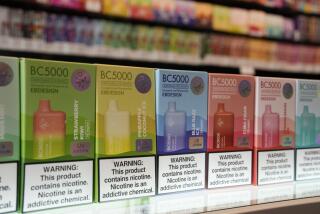Study Suggests Shift in Teen Sex Practices
- Share via
More than half of American teens ages 15 to 19 have engaged in oral sex, increasing to nearly 70% for those who are 18 and 19, according to the largest federal study of the nation’s sexual practices.
The study also found that 11% of women ages 18 to 44 reported having at least one homosexual experience in their lifetime, up from 4% in a similar survey conducted in 1992.
Taken together, the two findings suggest a shift in sexual practices, in which females are using oral and lesbian sex “as a safer alternative than [vaginal] sex with men,” said epidemiologist William D. Mosher of the National Center for Health Statistics, the study’s lead author.
“If it is seen as a safer alternative, it is an interesting response to the campaigns to reduce teen pregnancy and to reduce sexually transmitted diseases and HIV,” he said.
However, only 9% of the teens reported using condoms during oral sex. Studies have shown that gonorrhea, syphilis, genital herpes and human papillomavirus can be transmitted in this manner.
“They have not been given a strong enough message about the health risks of oral sex,” said Dr. Claire Brindis of UC San Francisco.
James Wagoner, president of Advocates for Youth, a reproductive health organization in Washington, D.C., said the study showed that society was undergoing a social transition, with women and girls becoming more sexually confident.
“It calls into question the stereotype of boys as hunters and girls as prey,” he said. “Something going on here is creating more balance between the sexes than we have seen before.”
But Brindis cautioned that some of the apparent increases may simply represent an increased comfort level in discussing sexual behavior rather than an increase in activity.
Some may now “be disclosing information that had probably occurred for decades,” she said.
Economist M.V. Lee Badgett, a visiting scholar at UCLA and research director of the Institute for Gay and Lesbian Strategic Studies, echoed that sentiment. “The world has changed in 10 years,” she said.
Badgett noted that the 1990 census showed 150,000 households of same-sex couples in the nation, but 600,000 were reported in 2000. In both cases, she said, the differences “are much more likely to be due to a willingness to report than to an increase in numbers.”
The yearlong study, which began in March 2002, involved in-home interviews of 12,571 people conducted by female researchers. The most recent similar study, a decade earlier, involved 3,300 interviews.
The researchers asked a variety of health-related questions, which were presented on a computer so the interviewees could respond while maintaining anonymity.
The form of the question is crucial in such studies, noted epidemiologist Susan Cochran of UCLA. In the survey, women were asked, “Have you ever had any sexual experience of any kind with another female?” That question can encompass a variety of behaviors ranging from sexual intimacy to cuddling or a kiss, Cochran said.
She cited an Australian study that found that 8.6% of women answered affirmatively to a question similar to that on the U.S. survey, but 5.7% did so when the question specifically asked about genital contact.
“What’s happening is that our definition of sexual behavior has broadened,” she said.
Similar arguments can be made about the reports of teen sexual behavior, but most experts agreed that the findings represented a phenomenon.
There have been widespread anecdotal reports that teens are increasingly engaging in oral sex to prevent pregnancy and the transmission of sexual diseases, but this survey is the first to document the incidence on a national level, Mosher said.
“It’s good to finally have some reliable information on that,” he said.
The data show that, among teens 15 to 19, 55% of males and 54% of females reported engaging in oral sex. Among those 18 to 19, the figure grows to about 70% for both sexes. Overall, more teens had experienced oral sex than vaginal sex: 53% of girls 15 to 19 and 49% of boys reported that they had had intercourse.
Among teens who had never had intercourse, about a quarter of males and females reported having oral sex. But by age 23, when most people have already had vaginal sex, the figure declined to 3%.
The figures for teen boys are not much different from those in earlier studies, but there are no comparable data for females, Mosher said.
Oral sex was most common among white teens with families in the higher-income brackets.
“Those teens who are less likely to have sexual intercourse are more likely to have had oral sex,” said Jennifer Manlove, who directs research on fertility and family structures at Child Trends, a Washington research group on children and families. “We’re not sure whether these teens ... are engaging in oral sex because they view it as a way to maintain their technical virginity or even because they regard it as an ‘easy’ method of birth control,” she said.
The emphasis over the last five years on promoting abstinence from sex has led to widespread neglect of discussions about the safety of various sexual practices, Wagoner said.
“One of the most shocking statistics now is that the incidence of teen gonorrhea in the United States is 70 times that in the Netherlands and France,” he said. “We are paying a big price for shutting down discussion.”
Dr. Marvin E. Belzer, a specialist in adolescent medicine at Childrens Hospital Los Angeles, said: “Nobody really knows what the causes of high levels of oral sex are. The bigger issue is, as a society, as parents, as physicians, we do not adequately train our kids about healthy sexuality. The messages they get are from each other and they are often unhealthy.”
More to Read
Sign up for Essential California
The most important California stories and recommendations in your inbox every morning.
You may occasionally receive promotional content from the Los Angeles Times.













